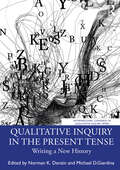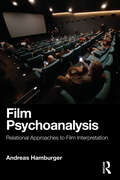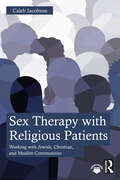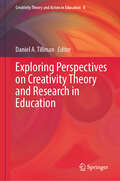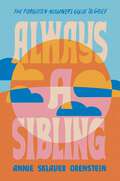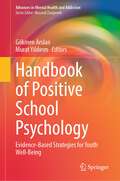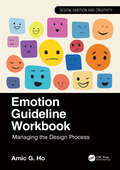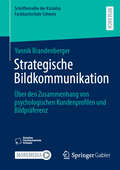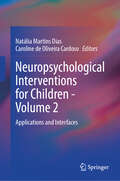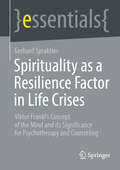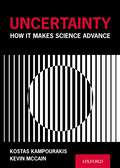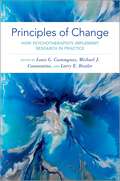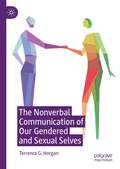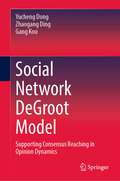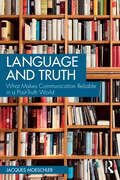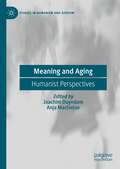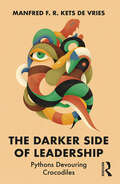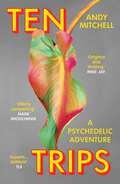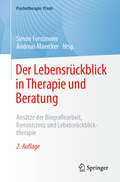- Table View
- List View
Qualitative Inquiry in the Present Tense: Writing a New History (International Congress of Qualitative Inquiry Series)
by Norman K. Denzin Michael D. GiardinaIn Qualitative Inquiry in the Present Tense, contributors engage with epistemological and philosophical questions concerning the conduct of qualitative inquiry in the present moment, and especially as it relates to various understandings of writing in/as inquiry.Topics addressed include methodological processes, questions of narrative uprootedness, relational inquiry, Indigenous ethico-onto-epistemologies, storytelling, and transformative writing forms and practices. This is a messy, often unruly collection (in the best way possible) of disparate ideas strung tightly together by literal and metaphorical questions of the research act of writing. Contributors from the United States, Australia, Canada, England, and Scotland imaginatively conceive of new qualitative futures—and how we might write ourselves there.This evocative new book is a must-read for faculty and students alike who are interested in and engaged with questions and ideas oriented toward understanding our current historical present in qualitative research—a moment in which the field is perpetually in motion or in flux, with new theories, methods, and orientations arising, competing, and even contradicting one another.
Qualitative Inquiry in the Present Tense: Writing a New History (International Congress of Qualitative Inquiry Series)
by Norman K. Denzin Michael D. GiardinaIn Qualitative Inquiry in the Present Tense, contributors engage with epistemological and philosophical questions concerning the conduct of qualitative inquiry in the present moment, and especially as it relates to various understandings of writing in/as inquiry.Topics addressed include methodological processes, questions of narrative uprootedness, relational inquiry, Indigenous ethico-onto-epistemologies, storytelling, and transformative writing forms and practices. This is a messy, often unruly collection (in the best way possible) of disparate ideas strung tightly together by literal and metaphorical questions of the research act of writing. Contributors from the United States, Australia, Canada, England, and Scotland imaginatively conceive of new qualitative futures—and how we might write ourselves there.This evocative new book is a must-read for faculty and students alike who are interested in and engaged with questions and ideas oriented toward understanding our current historical present in qualitative research—a moment in which the field is perpetually in motion or in flux, with new theories, methods, and orientations arising, competing, and even contradicting one another.
Film Psychoanalysis: Relational Approaches to Film Interpretation
by Andreas HamburgerThrough the development of psychoanalytically informed film interpretation, Andreas Hamburger provides new insights into the experience of watching films and their influence upon our internal lives.Building upon a relational understanding of psychoanalysis, this volume develops a methodical procedure for psychoanalytical film interpretation, discusses individual aspects of the medium – such as editing, spatial and temporal design – and puts approaches to film psychoanalysis and cinema theory into a systematic perspective. Hamburger exemplifies his arguments in a detailed analysis of numerous film examples and demonstrates how an in-depth encounter with the medium can provoke new and surprising understandings. Providing an interdisciplinary perspective that crosses the study of popular culture with psychoanalytic theory, this book will be required reading not only for students and scholars of film, but also for psychoanalysts in practice and training.
Film Psychoanalysis: Relational Approaches to Film Interpretation
by Andreas HamburgerThrough the development of psychoanalytically informed film interpretation, Andreas Hamburger provides new insights into the experience of watching films and their influence upon our internal lives.Building upon a relational understanding of psychoanalysis, this volume develops a methodical procedure for psychoanalytical film interpretation, discusses individual aspects of the medium – such as editing, spatial and temporal design – and puts approaches to film psychoanalysis and cinema theory into a systematic perspective. Hamburger exemplifies his arguments in a detailed analysis of numerous film examples and demonstrates how an in-depth encounter with the medium can provoke new and surprising understandings. Providing an interdisciplinary perspective that crosses the study of popular culture with psychoanalytic theory, this book will be required reading not only for students and scholars of film, but also for psychoanalysts in practice and training.
Sex Therapy with Religious Patients: Working with Jewish, Christian, and Muslim Communities
by Caleb JacobsonSex Therapy with Religious Patients is a comprehensive guidebook for mental health professionals who work with those struggling with sexual issues within a religious context. The book provides practical guidance on how to approach sensitive topics related to sex and religion, including addressing religious beliefs and values that may impact sexual behavior, beliefs, and attitudes.Drawing on research and clinical experience, the book offers a range of evidence-based interventions for working with individuals from different Jewish, Christian, and Muslim backgrounds. It also explores the unique challenges and opportunities presented by patients’ religious beliefs and provides strategies for integrating spirituality into the therapeutic process.The book is written in an accessible and engaging style, with real-life case examples and exercises that can be used in therapy sessions. It is an essential resource for mental health professionals seeking to enhance their skills in working with religious individuals who are seeking sex therapy.
Sex Therapy with Religious Patients: Working with Jewish, Christian, and Muslim Communities
by Caleb JacobsonSex Therapy with Religious Patients is a comprehensive guidebook for mental health professionals who work with those struggling with sexual issues within a religious context. The book provides practical guidance on how to approach sensitive topics related to sex and religion, including addressing religious beliefs and values that may impact sexual behavior, beliefs, and attitudes.Drawing on research and clinical experience, the book offers a range of evidence-based interventions for working with individuals from different Jewish, Christian, and Muslim backgrounds. It also explores the unique challenges and opportunities presented by patients’ religious beliefs and provides strategies for integrating spirituality into the therapeutic process.The book is written in an accessible and engaging style, with real-life case examples and exercises that can be used in therapy sessions. It is an essential resource for mental health professionals seeking to enhance their skills in working with religious individuals who are seeking sex therapy.
Exploring Perspectives on Creativity Theory and Research in Education (Creativity Theory and Action in Education #8)
by Daniel A. TillmanCollectively, the sixteen chapters in this book investigate the power of creativity in the classroom, many through the specific lens of limited resources as an opportunity. The chapters are divided into two sections, eight chapters comprising Section I: Theory and Research and then the eight chapters comprising Section II: Additional Perspectives and Future Directions. Within these two sections, the more than two-dozen authors that contributed to this book tackle a wide range of the possibilities for designing creative classroom-based instruction wherein limited resources are highlighted and valued, rather than avoided or lamented. The two main sections of this book are each preceded by a brief introductory summary highlighting those sections’ attributes and objectives, with the intention of providing helpful structure to the reader—but the book has also been designed such that each chapter stands independently and can be jumped to directly like a handbook. In its totality, this book exploring perspectives on creativity theory and research in education is designed to serve as a valuable resource for teachers, teacher educators, school administrators, parents, and education researchers, along with anyone else that is interested in optimizing our opportunities for nurturing creativity within classrooms.
Always a Sibling: The Forgotten Mourner's Guide to Grief
by Annie Sklaver OrensteinA practical, compassionate guide to sibling loss, with research, stories, and strategies for &“forgotten mourners&” as they move through the stages of grief towards finding meaning. After her brother was killed by a suicide bomber in Afghanistan, Annie Sklaver Orenstein was heartbroken and unmoored. Standing in the grief section of her local bookstore, she searched for guides on how to work through her grief as a mourning sibling—and found nothing. More than 4 million American adults each year will lose a sibling, yet there isn't a modern resource guide available that speaks directly to this type of grief that at times can be overshadowed by grieving parents and spouses and made even more difficult by the complexities of sibling dynamics. In AlwaysaSibling, Annie uses her own story and those of others to create the empathic, thoughtful, practical resource that she sought. Divided into three sections: With, Without, and Within, it creates a framework that enables the reader to ground themselves in order to process and validate this often overlooked grief. Annie guides readers to capture the memories and emotions of life with their now deceased sibling, then moves to addressing the grieving process in detail as they navigate life without them. Ultimately, readers will find ways to experience their sibling's presence within themselves and acknowledge their legacy. With practical strategies rooted in proven grief processing techniques, trauma recovery, and psychoanalysis, Always A Sibling truly supports mourners through the unique experience of sibling loss.
Handbook of Positive School Psychology: Evidence-Based Strategies for Youth Well-Being (Advances in Mental Health and Addiction)
by Gökmen Arslan Murat YıldırımStudents spend significantly more time in school compared to any other formal institution during their lives; therefore, mental health in schools has attracted a lot of attention in recent years. According to Seligman et al. (2009), positive psychology in school is a response to the gap between what people want for their children and what schools teach. That is, most parents want their children to be happy, healthy, and confident, but schools only focus on achievement, discipline, and academic skills. These are of course important, but so are positive mental health outcomes. To fix this gap, schools must teach achievement and accomplishment along with positive psychology-informed mental health skills. In other words, positive education aims to bring positive psychology’s goals of well-being and mental health support for everyone into the school setting.Psychological interventions have been around in schools since at least the 1930s. Therefore, it makes sense to supplement the already-existing traditional psychology in schools with positive psychology. In the field of psychology, positive psychology interventions are defined as those aimed at raising positive feelings, positive thoughts, and positive behaviour and increasing well-being. Positive Psychology Interventions in schools have been shown to improve mental health and well-being outcomes for students. Recent research has confirmed the same results, as offering emotional support early in a school year can lead to improved instructional quality later in that school year. In other words, positive school psychology interventions offer a focus on mental health in order to set the stage and give students the opportunity for academic achievement. Since the beginning of the positive psychology movement, the application of its assumptions in schools has been one of the movement’s main pillars. The objective of the book is to help counsellors, teachers, and school leaders engage in a positive psychology research-based practice in schools.
Emotion Guideline Workbook: Managing the Design Process (Design, Emotion and Creativity)
by Amic G. HoManipulating the design process can be challenging for junior design, art and creative students. Besides understanding the approaches to managing the design factors with logical thinking, they can lack experience in handling emotional changes and concerns and initiative factors during the design process. As a result, they struggle to practice design and need guidance for enhancing their decision-making, evaluation, judgment, and motivation.This book proposes a set of guiding principles with the intention of assisting the reader in regulating the emotional changes that occur throughout the design process. This book offers practical approaches to those who would like to incorporate emotion in their design processes, which contrasts with previous scholarly research that has mostly focused on the theoretical level. It provides guidance to the reader through the process of adapting to the emotional changes that may occur throughout the design process during their design studies. It contains a literature review, research methods and a discussion of the strengths and limitations. Featuring printable worksheets and additional tables to use as guidance, this highly practical text allows the reader to gain a full understanding of emotion in the design procedure through active involvement process.The Emotion Guideline Workbook is perfect for design, art and creative students, as well as their instructors, researchers, and other learners who are interested in emotion-driven design. It will also appeal to students and academics in the fields of psychology and education.
Emotion Guideline Workbook: Managing the Design Process (Design, Emotion and Creativity)
by Amic G. HoManipulating the design process can be challenging for junior design, art and creative students. Besides understanding the approaches to managing the design factors with logical thinking, they can lack experience in handling emotional changes and concerns and initiative factors during the design process. As a result, they struggle to practice design and need guidance for enhancing their decision-making, evaluation, judgment, and motivation.This book proposes a set of guiding principles with the intention of assisting the reader in regulating the emotional changes that occur throughout the design process. This book offers practical approaches to those who would like to incorporate emotion in their design processes, which contrasts with previous scholarly research that has mostly focused on the theoretical level. It provides guidance to the reader through the process of adapting to the emotional changes that may occur throughout the design process during their design studies. It contains a literature review, research methods and a discussion of the strengths and limitations. Featuring printable worksheets and additional tables to use as guidance, this highly practical text allows the reader to gain a full understanding of emotion in the design procedure through active involvement process.The Emotion Guideline Workbook is perfect for design, art and creative students, as well as their instructors, researchers, and other learners who are interested in emotion-driven design. It will also appeal to students and academics in the fields of psychology and education.
Strategische Bildkommunikation: Über den Zusammenhang von psychologischen Kundenprofilen und Bildpräferenz (Schriftenreihe der Kalaidos Fachhochschule Schweiz)
by Yannik BrandenbergerIn einer sich rasant verändernden Marketinglandschaft wird die Bedeutung einer authentischen Verbindung zwischen Unternehmen und Konsumenten immer dringlicher. Statt mit Inhalten zu überfluten, liegt die Herausforderung darin, durch gezielte visuelle Kommunikation eine tiefere Bindung aufzubauen. Diese Herausforderung wird besonders in der fehlenden Anpassung von Bildern an die psychologischen Profile der Zielgruppe deutlich, für die bisher kein empirisch validiertes Modell existiert. In diesem Buch wird ein tiefer Einblick in den Zusammenhang zwischen psychologischen Kundenprofilen und Bildpräferenzen durch die Untersuchung und Weiterentwicklung des EIC-Modells gewonnen. Die empirischen Ergebnisse, gewonnen aus einer Studie mit 95 Teilnehmenden, bestätigen diese Verbindung und eröffnen neue Perspektiven für die strategische Bildkommunikation. Als Resultat dieser Forschung präsentiert sich das ICS-Modell – ein Instrument, das Fotograf*innen und Marketingexpert*innen befähigt, die Bildkommunikation gezielt auf Zielgruppen auszurichten. Dieses Buch bietet nicht nur einen Einblick in die theoretischen Grundlagen, es regt auch dazu an, wie diese Erkenntnisse in der Praxis für eine wirkungsvolle visuelle Kommunikation genutzt werden können.
Neuropsychological Interventions for Children - Volume 2: Applications and Interfaces
by Caroline de Oliveira Cardoso Natália Martins DiasThis book is the second of two volumes that aim to serve as a comprehensive guide for professionals working with neuropsychological interventions especially designed for children. This second volume complements the theoretical and practical foundations presented in the first volume by presenting applications to different clinical conditions and by exploring interfaces of neuropsychology with other areas of research and practice. Chapters in this second volume are divided into two parts. The first part presents a series of case studies, illustrating the practice and experience of neuropsychological rehabilitation and habilitation in different clinical conditions. The second part brings together chapters that discuss the interfaces of neuropsychology with different areas, which can use its knowledge and interventions (such as school neuropsychology) or which can be used as strategies within neuropsychological intervention or even compose inter and transdisciplinary partnerships in the work of promotion, stimulation, or cognitive remediation, such as the use and role of music, games and play, mindfulness, and transcranial direct current stimulation. So, chapters in this second part highlight the interfaces with other approaches, knowledges or disciplines. Originally published in Portuguese and now available in English, Neuropsychological Interventions for Children – Volumes 1 and 2 will be of interest to professionals working with neuropsychology in clinical and school contexts. It will also be useful in neuropsychology teaching contexts (specialization courses in neuropsychology and related areas) and for students and professionals in interface areas, such as Psychology, Education, Speech Therapy, Occupational Therapy among others. The translation of the original Portuguese version of this book into English was done with the help of artificial intelligence. A subsequent human revision was done primarily in terms of content.
Spirituality as a Resilience Factor in Life Crises: Viktor Frankl's Concept of the Mind and its Significance for Psychotherapy and Counseling (essentials)
by Gerhard SpraktiesThis essential illustrates to psychotherapists and counselors the importance of spirituality for strengthening personal resilience. We live in often exhausting and fast-moving times. The 21st century began with a series of crises on a global scale: the terrorist attacks of 9/11, the financial crisis, climate change, the coronavirus pandemic and the war in Ukraine. Many media outlets today are true artists when it comes to describing unsuccessful lives. Anyone who is constantly preoccupied with negative news runs the risk of losing their inner mental balance. They are in danger of falling into a mood characterized by gloom and resignation. Experienced spiritual counselor and logotherapist Gerhard Sprakties shows how a deep spiritual foundation can help us to deal with these challenges in a constructive way.
Uncertainty: How It Makes Science Advance
by Kostas Kampourakis Kevin McCainScientific knowledge is the most solid and robust kind of knowledge that humans have because of the self-correcting character inherent in its own processes. Nevertheless, anti-evolutionists, climate denialists, and anti-vaxxers, among others, question some of the best-established scientific findings, making claims that are unsupported by empirical evidence. A common aspect of these claims is the reference to the uncertainties in these areas of research, which leads to the conclusion that science is uncertain about evolution, climate change, and vaccination, among others. The truth of the matter is that while the broad picture is clear, there exist--and will always exist--uncertainties about the details of the respective phenomena. In this book Kampourakis and McCain show that uncertainty is an inherent feature of science that does not devalue it. In contrast, uncertainty actually makes science advance because it motivates further research. The first book of its kind, Uncertainty draws on philosophy of science to explain what uncertainty in science is and how it makes science advance. It contrasts evolution, climate change, and vaccination, where the uncertainties are exaggerated, to genetic testing and forensic science where the uncertainties are usually overlooked. Kampourakis and McCain discuss the scientific, psychological, and philosophical aspects of uncertainty in order to explain what it is really about, what kind of problems it actually poses, and why it ultimately makes science advance. Contrary to the public representations of scientific findings and conclusions that produce an intuitive but distorted view of science as certain, we need to understand and learn to live with uncertainty in science.
Principles of Change: How Psychotherapists Implement Research in Practice
by Louis G. Castonguay, Michael J. Constantino, and Larry E. BeutlerPrinciples of Change constitutes a new approach to evidence-based practice in psychotherapy that goes beyond the traditional and unidirectional dissemination of research, whereby clinicians are typically viewed as passive recipients of scientific findings. Based on an extensive review of literature, it first offers a list of 38 empirically based principles of change grouped in five categories: client prognostic, treatment/provider moderating, client process, therapeutic relationship, and therapist interventions. Six therapists from diverse theoretical orientations then describe, in rich and insightful detail, how they implement each of these principles. The book also offers exchanges between researchers and clinicians on several key issues, including: how similarly and differently change principles are addressed or used across a variety of treatments; and how clinicians' observations and reflections can guide future research. By presenting together these unique yet complementary experiences, Principles of Change will support synergetic advances in understanding and improving psychotherapy, laying the foundation for further collaborations and partnerships between stakeholders in mental health services.
The Nonverbal Communication of Our Gendered and Sexual Selves
by Terrence G. HorganThis book provides a comprehensive guide to the latest research on the nonverbal cues that signal our biological sex, gender, and sexual orientation to others, as well as our sexual/romantic interest in others. Crucially, it is a volume which incorporates critical perspectives which help to tackle the short-comings associated with the predominant focus on cis-gender, heterosexual individuals . It underscores how specific cues work in conjunction with other cues during the communication of our gendered and sexual selves, and how various factors (cultural, contextual, social, personality variables) impact that process. It also addresses common misconceptions including the notion that the romantic landscape has become more sexualized and predominantly technology driven. This book highlights that we still tend to communicate a romantic interest in each other in quite traditional places, such as school, home, and social events, using tried-and-true nonverbal cues, like gazing and smiling. Across six chapters readers will learn about the cues to our gendered and sexual selves, which exist in our facial and bodily movements, dress, personal artifacts, gestures, body odor, vocal characteristics, touch, and posture, amongst others. This engaging work presents historical and contemporary research findings that will appeal to students and scholars of nonverbal communication, communication studies, the psychology of gender, and sexuality studies.
Social Network DeGroot Model: Supporting Consensus Reaching in Opinion Dynamics
by Gang Kou Yucheng Dong Zhaogang DingThis book investigates the DeGroot model in social network contexts, and proposes the social network DeGroot (SNDG) model. Specifically, this book focuses on two core research problems in the SNDG model: (i) Social network structures to reach a stable state (consensus, polarization, or fragmentation); and (ii) the convergence rate to reach a stable state. Furthermore, the authors generalize the SNDG model in an uncertain context, showing the effects of interval opinions on the SNDG model. In this book, the authors also discuss the applications of the SNDG model to support group decision making, including consensus reaching through adding minimum interactions, trust relationships manipulations, and risk control issues in the social network. Apart from theoretical analysis, detailed experimental simulations with real and random data will be applied to validate our research.This book is the first to connect opinion dynamics, social network and group decision making. The resultsreported can help us understand the evolution of public opinions in social network contexts and provide new tools to support consensus reaching in group decision making.
Language and Truth: What Makes Communication Reliable in a Post-Truth World
by Jacques MoeschlerThe nature of truth is a current preoccupation both in political and social debates. The emergence and consequences of fake news and misinformation are at the core of what some call a post-truth world.Divided into two parts, Language and Truth develops the theoretical framework of language, truth, and communication. The book illustrates the way in which fake news is adhered to or rejected using case studies taken from political discourse such as the recent use of the word’s “genocide” and “denazification” by Vladimir Putin. It explores sources of information such as gossip and the everyday as well as exceptional uses of language such as humour.This is vital reading for scholars, researchers, and students of pragmatics, semantics, philosophy of language, cognitive psychology, sociolinguistics, language and communication, and language and politics within linguistics, psychology, and communication studies.
Meaning and Aging: Humanist Perspectives (Studies in Humanism and Atheism)
by Anja Machielse Joachim DuyndamThe main objective of this book is to add, from a humanist perspective, new interdisciplinary insights and research results to the current academic debate on aging. The collection aims to enhance and complement the predominantly biomedical and sociological debates and provide a more comprehensive and highly topical view on aging and old age. By purveying a meaning-in-life perspective to the current debate we want to enrich and to deepen the research on aging, thus aspiring to an ideal of meaningful aging. The starting point of this book is a humanistic meaning frame for addressing basic needs of a meaningful existence, such as having goals in life, a sense of self-worth, connectedness with others, moral justification, a certain degree of understanding (comprehensibility), direction and influence with a view to cohesion in life, and not in the least place: (living) pleasure or excitement. Taken together, the essays show that experiencing a meaningful life contributes to one’s mentalresilience, conceived as the ability to realize a humane individuality (autonomy) in thinking and acting in situations of adversity and vulnerability, particularly those faced by older people.
Language and Truth: What Makes Communication Reliable in a Post-Truth World
by Jacques MoeschlerThe nature of truth is a current preoccupation both in political and social debates. The emergence and consequences of fake news and misinformation are at the core of what some call a post-truth world.Divided into two parts, Language and Truth develops the theoretical framework of language, truth, and communication. The book illustrates the way in which fake news is adhered to or rejected using case studies taken from political discourse such as the recent use of the word’s “genocide” and “denazification” by Vladimir Putin. It explores sources of information such as gossip and the everyday as well as exceptional uses of language such as humour.This is vital reading for scholars, researchers, and students of pragmatics, semantics, philosophy of language, cognitive psychology, sociolinguistics, language and communication, and language and politics within linguistics, psychology, and communication studies.
The Darker Side of Leadership: Pythons Devouring Crocodiles
by Manfred F. Kets de VriesManfred Kets de Vries is one of the most authoritative voices on organizational dynamics, leadership, executive coaching, and psychotherapy today. In all his roles, he has noticed that questions are now, increasingly, coming back to one thing – the wider state of the world. Using an engaging and highly readable style throughout the book, Manfred helps us to make sense of the confusing and, some might say, psychotic times in which we now live.Revealing the darker side of leadership, Manfred explores the tendency for people to adopt ‘sheeple’ or herd-like behavior, the populist threat that we are facing, the dangers that come with feelings of perceived injustice, the rise of dictatorships, and the impact of Leviathan (neo-authoritarian) leadership behavior. Guided by theoretical concepts, the book provides readers with a better understanding of the underlying forces that drive these phenomena to the surface. What are the psychological dynamics at play? Why do groups of people behave in this manner? Beyond merely diagnosing what’s happening, Manfred introduces various coping strategies to counteract the emergence of these regressive forces.The book offers a unique and original approach to answering the micro- and macro-psychological questions of how to mitigate against populism and autocratic leadership, and will be of interest to the general reader as well as the key audiences of organizational leaders, psychoanalysts, coaches, psychotherapists, sociologists and social psychologists.
The Darker Side of Leadership: Pythons Devouring Crocodiles
by Manfred F. Kets de VriesManfred Kets de Vries is one of the most authoritative voices on organizational dynamics, leadership, executive coaching, and psychotherapy today. In all his roles, he has noticed that questions are now, increasingly, coming back to one thing – the wider state of the world. Using an engaging and highly readable style throughout the book, Manfred helps us to make sense of the confusing and, some might say, psychotic times in which we now live.Revealing the darker side of leadership, Manfred explores the tendency for people to adopt ‘sheeple’ or herd-like behavior, the populist threat that we are facing, the dangers that come with feelings of perceived injustice, the rise of dictatorships, and the impact of Leviathan (neo-authoritarian) leadership behavior. Guided by theoretical concepts, the book provides readers with a better understanding of the underlying forces that drive these phenomena to the surface. What are the psychological dynamics at play? Why do groups of people behave in this manner? Beyond merely diagnosing what’s happening, Manfred introduces various coping strategies to counteract the emergence of these regressive forces.The book offers a unique and original approach to answering the micro- and macro-psychological questions of how to mitigate against populism and autocratic leadership, and will be of interest to the general reader as well as the key audiences of organizational leaders, psychoanalysts, coaches, psychotherapists, sociologists and social psychologists.
Ten Trips: The New Reality of Psychedelics
by Andy Mitchell‘An original and thrilling investigation into psychedelics and the claims that currently surround them, achieving profound insights into their essential qualities’ Mike Jay, author of Psychonauts Psychedelics have made a comeback, but the truth is they remain a mystery.In this daring, profound and wildly entertaining investigation, clinical neuropsychologist Andy Mitchell tests the claims being made for these substances by taking ten different psychedelics in ten different settings.Journeying from a neuroimaging lab in London to the Colombian Amazon via Silicon Valley and his friend’s basement kitchen, his encounters with scientists and gangsters, venture capitalists and con men, psychonauts and shamans, and above all with the drugs themselves, take us beyond the hype and reveal the reality of psychedelics – that they are as enchanting but ultimately unfathomable as experience itself.‘Utterly compelling. Some books are in a category of their own and this is one them. Reading it is like having an out of body experience’ Mark Miodownik, author of Stuff Matters'An incisive, deeply personal and beautifully written account of the power, the uses and the modern misuses of psychedelics. Highly recommended' Anil Seth, author of Being You‘Wonderful . . . a journey into the nature and potential of consciousness itself’ Literary Review‘Superb . . . brilliant’ TLS
Der Lebensrückblick in Therapie und Beratung: Ansätze der Biografiearbeit, Reminiszenz und Lebensrückblicktherapie (Psychotherapie: Praxis)
by Andreas Maercker Simon ForstmeierIn diesem Buch werden die Wurzeln, Methoden und Möglichkeiten der Lebensrückblicktherapie, Biografiearbeit und weiterer Reminiszenzinterventionen dargestellt. Der Ansatz ist dabei alters- und schulenübergreifend. Der Lebensrückblick wird als Intervention behandelt, die zur Identitätsarbeit, Sinnfindung und Ressourcenorientierung und als narrativer Ansatz bei verschiedener Symptomatik und verschiedener Klientel eingesetzt werden kann. Seit einiger Zeit ist über alle Schulenorientierungen hinweg das Interesse an Lebensrückblickinterventionen gewachsen. Formen der biografischen Arbeit werden mit Kindern und Jugendlichen in schwierigen Lebenssituationen, psychisch Kranken und älteren Menschen eingesetzt. Die psychotherapeutische Hauptform ist die Lebensrückblicktherapie. Forschungsergebnisse zeigen, dass sie zu den wirksamsten antidepressiven Verfahren gehört, so dass eine breite Anwendung in der Psychotherapie zu empfehlen ist. Geschrieben für Psychotherapeut:innen, Psychiater:innen, Psychosomatische Mediziner:innen, Sozialarbeiter:innen, Seelsorger:innen und andere im sozialen/therapeutischen Bereich Tätige.
